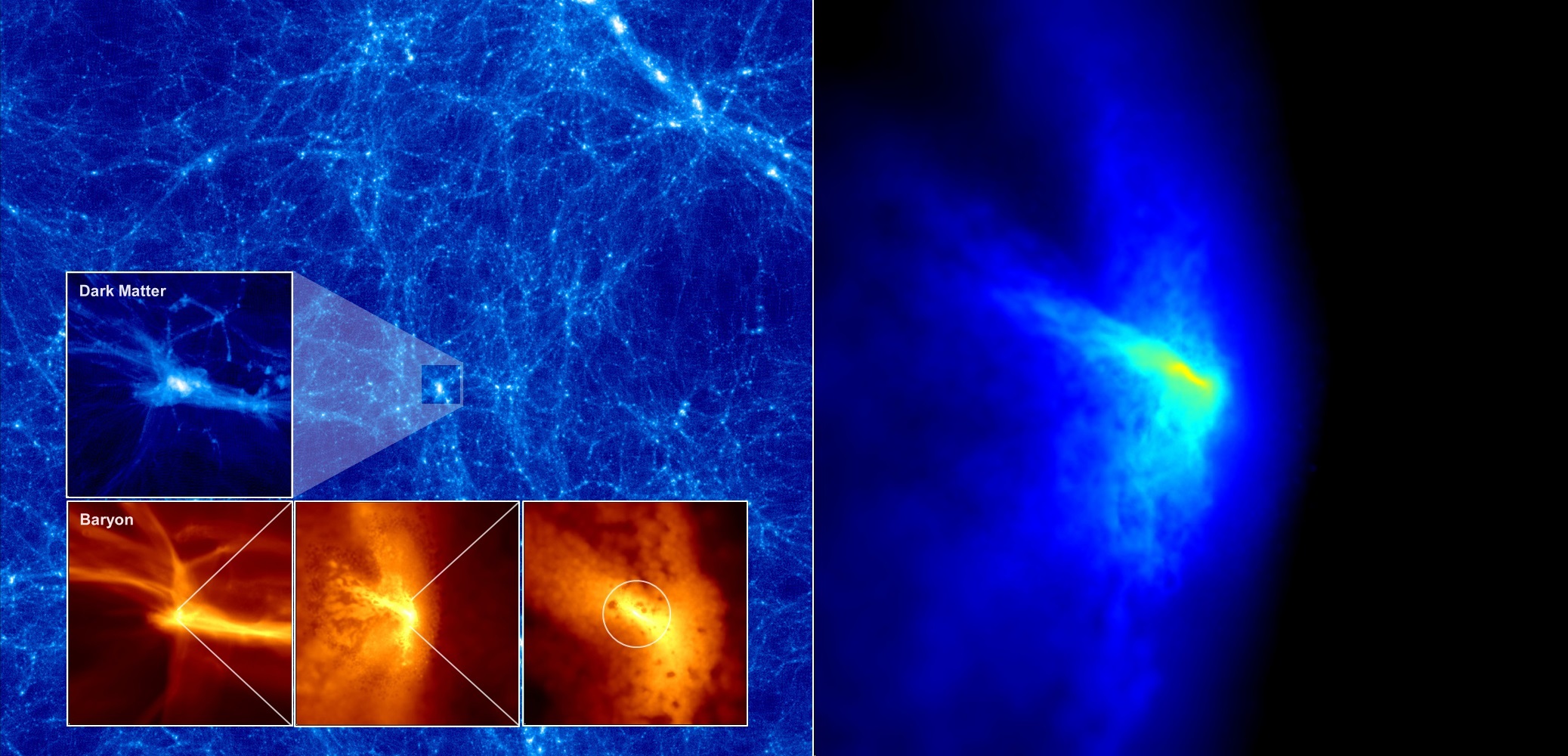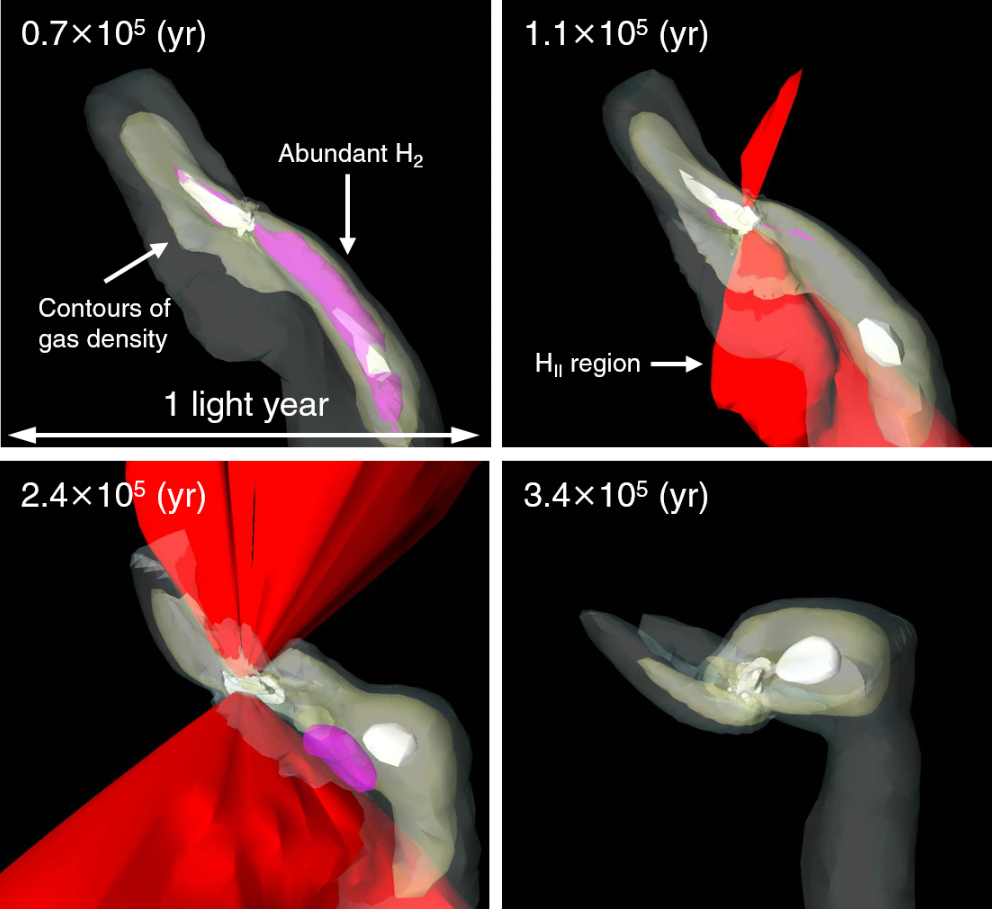Supersonic gas streams left over from the Big Bang drive massive black hole formation
An international team of researchers has successfully used a super-computer simulation to recreate the formation of a massive black hole from supersonic gas streams left over from the Big Bang. This study shows this black hole could be the source of the birth and development of the largest and oldest super-massive black holes recorded in our Universe. The origin of the monstrous black holes has been a long-standing mystery and now this study provide a solution to it.
This research was published in Science on September 29th 2017.
*** Link for FREE access to this paper: Abstract / Reprint / Full text.
| Paper | Science |
| Title | Supersonic Gas Streams Enhance the Formation of Massive Black Holes in the Early Universe |
| Authors | Shingo Hirano1,2,*, Takashi Hosokawa2,3,4, Naoki Yoshida2,4,5, Rolf Kuiper6 |
| Affiliations | 1Department of Astronomy, University of Texas at Austin, 2Department of Physics, School of Science, University of Tokyo, 3Department of Physics, Kyoto University, 4Research Center for the Early Universe, University of Tokyo, 5Kavli Institute for the Physics and Mathematics of the Universe (WPI), UT Institutes for Advanced Study, University of Tokyo, 6University of T |
| Page | Vol.357, Issue 6358, pp. 1375-1378 |
| DOI | 10.1126/science.aai9119 |
| Preprint | arXiv:1709.09863 |
| Contact | *shirano_AT_astro.as.utexas.edu (_AT_ --> @) |
Background and Motivation
Recent discoveries of these super-massive black holes located 13 billion light years away, corresponding to when the universe was just five per cent of its present age, pose a serious challenge to the theory of black hole formation and evolution. The physical mechanisms that form black holes and drive their growth are poorly understood. Theoretical studies have suggested these black holes formed from remnants of the first generation of stars, or from a direct gravitational collapse of a massive primordial gas cloud. However, these theories either have difficulty in forming super-massive black holes fast enough, or require very particular conditions.
Formation of monstrous black hole seed
The research term identified a promising physical process through which a massive black hole could form fast enough. The key was incorporating the effect of supersonic gas motions with respect to dark matter. The team’s super-computer simulations showed a massive clump of dark matter had formed when the universe was 100 million years old. Supersonic gas streams generated by the Big Bang were caught by dark matter to form a dense, turbulent gas cloud. Inside, a protostar started to form, and because the surrounding gas provided more than enough material for it to feed on, the star was able to grow extremely big in a short amount of time without releasing a lot of radiation.

Figure 1 – (Left) Projected density distributions of dark matter (background and top panel) and gas (bottom three panels) components when the massive star forms. [No caption image] [Movie: Density distributions of dark matter and gas components under the supersonic streaming motion (17MB)] (Right) Close up showing gas density distribution around a protostar (centre). The high-speed gas flowing from the top left of the image to the right compresses the central gas cloud. The part in yellow to light-green shows the development of strong turbulence. [No caption image]

Figure 2 – Evolution of the temperature and density structure during the protostellar accretion phase. The rapid accretion of a dense gas cloud (white contour) causes the brightening of the star, and photoionized regions are lauched (red). [No caption image] [Movie: Protostellar accretion phase (1.5MB)]
Origin of the distant supermassive black holes
Once reaching the mass of 34,000 times that of our Sun, the star collapsed by its own gravity, leaving a massive black hole. These massive black holes born in the early universe continued to grow and merge together to become a supermassive black hole. The number density of massive black holes is derived to be approximately one per a volume of three billion light-years on a side – remarkably close to the observed number density of supermassive black holes.
The result from this study will be important for future research into the growth of massive black holes. Especially with the increased number of black hole observations in the far universe that are expected to be made when NASA’s James Webb Space Telescope is launched next year.
The numerical calculations and data analysis were carried out on – Aterui (Cray XC30) operated by the Center for Computational Astrophysics (CfCA), the National Astronomical Observatory of Japan (NAOJ) – COMA operated by the Center for Computational Sciences (CCS), University of Tsukuba
This research was supported by – JSPS KAKENHI grant JP14J02779, JP25800102, JP15H00776, and JP16H05996 – JST CREST JPMHCR1414 – MEXT Priority Issue 9 on Post-K Computer – the German Research Foundation (DFG) under grant no. KU 2849/3-1
LINK
- Paper [Science] [arXiv] Science's news
- Release
The University of Tokyo, School of Science [English]
Kavli Institute for the Physics and Mathematics of the Universe (Kavli IPMU) [English]
National Astronomical Observatory of Japan (NAOJ), Center for Computational Astrophysics (CfCA) [English]
The University of Texas at Austin [English]
The University of T
u bingen, Institute of Astronomy and Astrophysic [German] - News (By the syllabary order) EurekAlert, IFL Science, IBTimes, New Scientist, Newsweek, Newsy, Phys.org, ScienceDaily, Scientific American, Sky&Telescope, Space.com, The Daily Texan, The Register
- Authors Shingo Hirano (web) Takashi Hosokawa (web) Naoki Yoshida (web) Rolf Kuiper (web)